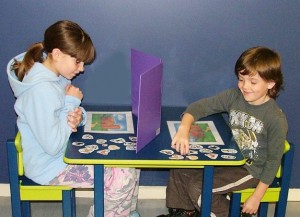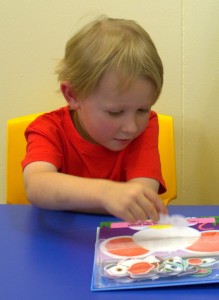
Speech pathologists love barrier games and they are great for parents, teachers, support workers and child care workers too, really anyone who works with children. Barrier games are a fun way to develop listening skills, oral language skills, social language skills, clear talking and understanding of concepts. They are great for extending the amount of information your child can understand or express within a sentence. Barrier games are fun, cooperative, flexible, portable and inexpensive. They are easy to adjust to different children's skill levels and to make more complex as a child progresses. They can be varied to suit a wide range of age groups and can be used with one child, in a pair or with a group.
Two weeks ago we had five ways to use barrier games to develop:
1. Listening and auditory memory.
2. Extended sentence length.
3. Vocabulary.
4. Understanding and use of concepts.
5. Descriptive language.
If you missed it here is the link!
Here are five more ways that you can use barrier games to target different skills and some more free downloads as well!
Barrier games require a listener, a speaker, two identical sets of materials and a barrier such as a large book that will stand up. The barrier is placed between the two players so that each cannot see the others materials. The speaker then arranges his materials and describes to the listener what they are doing. The listener arranges their materials in the same way. Your speech pathologist can supply you with picture sets to use and there are links throughout this blog of picture sets that you can download and print. Once you know how to do that it is easy to use other materials as well. Materials can include blocks, Lego, miniature objects, animals and figures, sticker sets, picture cards, coloured pencils and paper, real objects, maths materials, collage materials.

Here's how to use the picture sets:
- Print and laminate the sheets, with a set for each person. Leave the background sheet, or large pictures as a full page and cut up the small pictures into individual pictures. Each player should have one background sheet and one set of small pictures. You will also need a barrier such as a large book or folder.
- Next sit facing each other. Set down the background sheet and lay out the small pictures so that your child can see all of their pictures. Place your own background sheet and small pictures in front of yourself.
- Check that your child knows the names of all the small pictures. If there are any they do not not know remove them or teach the word to your child.
- Explain to your child that you are going to play a game to see that you are good listeners and talkers. Explain that you will put your pictures onto the background and tell the child what to do to make their picture look the same as yours. Tell them that they need to listen carefully, because they will not be able to see what you are doing. Stand up the barrier and explain that this is so that the child cannot see what you are doing and needs to listen carefully.
- Place your small pictures on the background one at a time and give your child clear instructions about how to put their pictures in the same position as you go. Make sure you give your child enough time to respond before giving the next instruction.
- When you have placed all the pictures on the background take the barrier away and talk to your child about the pictures that they have placed in the correct position. Explain to them that this means they have listened carefully. Explain the correct position of any pictures that the child may not have placed correctly.
- Play the game again and this time, tell your child that it is their turn to talk. Explain that you will listen carefully and make your pictures look the same as theirs. Put the barrier up again and ask the child to tell you where to put the pictures. If your child’s instructions are not clear, you may need to cue them such as if your child says “put the car there” you might say “I've got the car, but I'm not sure where to put it”.
- Take the barrier away and look at all the pictures that are correctly positioned and tell your child how this means that they did a good job of talking and that you listened carefully. Talk about any pictures that are in the incorrect position. Model the correct instruction such as “oh, I needed to put the cat under the tree”.
Once your child understands how to play barrier games, you can use a range of items from around the house to make your own games. You can use cut out pictures, from catalogues or clip art, objects and small toys from around the house, and toy or sticker sets from “cheap shops”. You can gradually make a barrier against more difficult by increasing the length and complexity of the instructions, and the number of items that need to be placed. You can introduce concepts of space such as: in, on, under, next to, above and below. You can also introduce concepts of colour and size.

Here are five more ways you can use them and some more downloads:
6. Developing grammar skills. There are a number of ways to use barrier games to develop use of grammatical structures. One way is to take turns with a barrier game and model the sentence structure you want your child to use. Repeat back their sentences correcting any errors they make. You can help your child include small grammar words such as articles a/the and prepositions in/on by using a sentence strip as a cue. Show your child how to put the small picture onto the strip and point to the words as they say the sentence. You can download some printable sentence strips for the beginner's barrier games here. If you do not have the beginner's barrier games from the previous blog you can download them here.
You can also use barrier games to target specific structures such as pronouns. Download some simple barrier games to practice the pronouns he/she and his/her here. Download some sentence strips for the pronoun game here. The realistic feedback provided in barrier games helps children learn to self monitor and self correct.
7. Transferring new speech sounds to conversation. Using sound loaded barrier games is a great way to practice newly learned speech sounds at a conversational level. You can download sound loaded barrier games for some common speech sound targets here: s barrier game, l barrier game and k barrier game.
8. Developing clearer speech. Barrier games provide opportunities for children to see in a real way how well other people have understood or not understood what they have said. They are a great way for children who mumble, speak to quickly, or too softly to practice using good clear speech to get their message across accurately. The listening partner just needs to give some clear, specific and honest feedback to the speaker. "When you speak so quickly, I am not sure what I need to do" or "When you said that slowly and clearly, I knew just what I needed to do".
9. Developing theory of mind. Theory of mind is about understanding other people's perspective. Developing theory of mind using barrier games works in much the same way as developing clear speech, by giving your child clear, specific feedback about how well you can understand their instructions. Children with poor theory of mind will often say things like "put that one over there" because they do not realise that you cannot see what they can see. By talking about this and pointing out that the barrier stops you seeing what they are seeing, they can learn to use more specific words as they learn to think about the perspectives of others. You can then use this understanding to develop their knowledge of theory of mind in broader contexts "You need to tell me all about what happened today at school because I was not there and did not see what happened".
10. Developing written language. Barrier games can be a fun way to encourage reluctant writers to write. You can begin by passing a page back and forth taking turns to write an instruction each, then move onto the child reading or writing the whole set of instructions. This takes considerable planning and sequencing skills as well as practicing handwriting, spelling and grammar.
Variations on barrier games for groups. Barrier games can be effectively in small groups and classes as well. Children can sit in a circle and one child sits with their back to the rest of the group and gives the instructions. Alternatively, children can take turns giving one instruction each. You can do barrier games as a whole class activity using photocopied background boards and instructions which involve drawing, pasting or colouring on the sheets.
We hope you have lots of fun learning all kinds of skills with barrier games.
Talking Matters team
To find out more about how the
Related Blog Posts
If you liked this post you may also like:
Use visuals everyday
Using praise
Individualised programs
Using UNO To Grow



